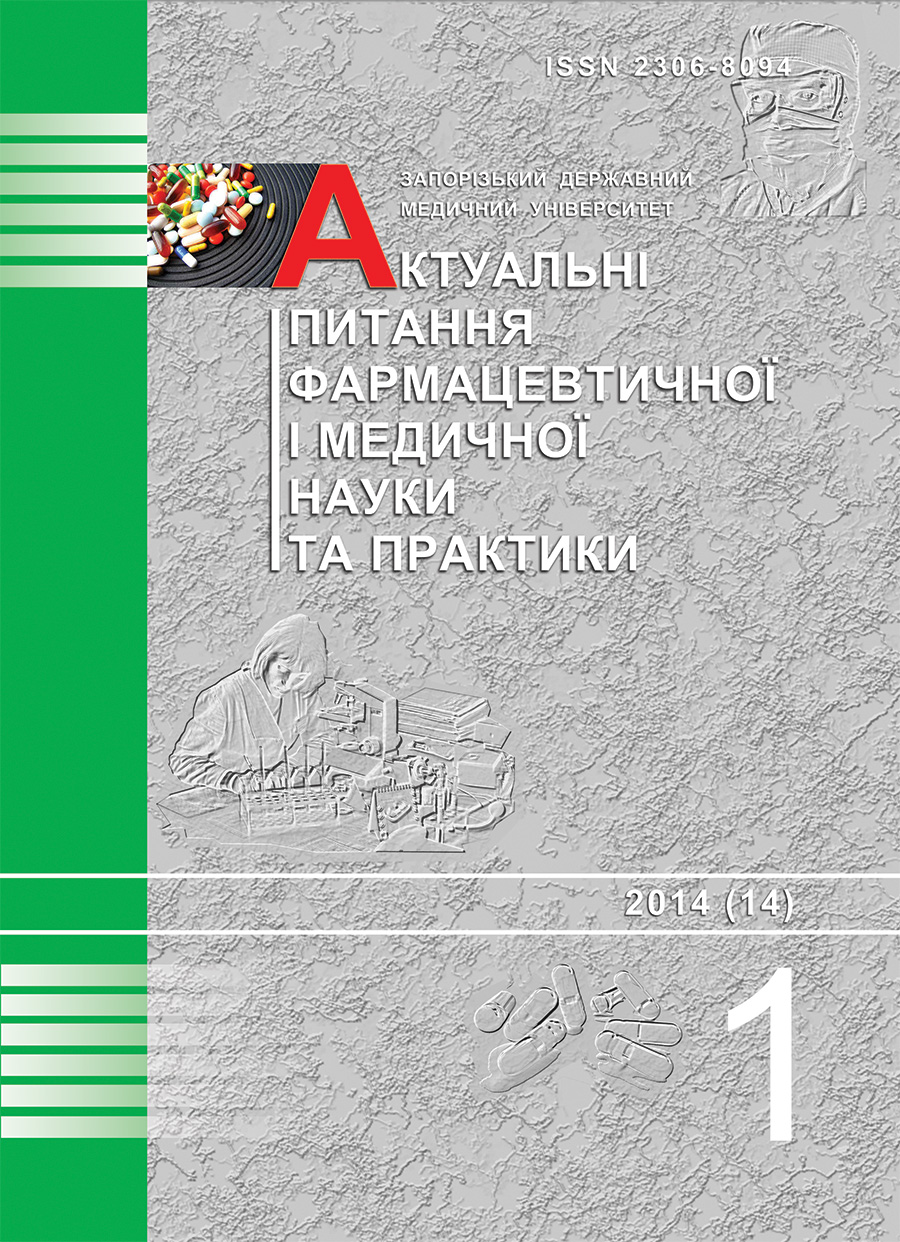Synthesis and properties’ investigation of 3-thio sulfonyl derivatives of 4-(2-methoxyphenyl)-5-alkyl(aryl)-1,2,4-triazole
DOI:
https://doi.org/10.14739/2409-2932.2014.1.24528Keywords:
sulfones, 1, 2, 4-triazole, antimicrobial activityAbstract
Introduction. 1,2,4-Triazoles derivatives are known to a number of scientists thanks to the valuable properties that appear in the antimicrobial, antifungal, analgesic, anticancer, antiviral, antituberculosis, anti-inflammatory, anticonvulsant and antidepressant activities and effects on the central nervous system. Thus, 5-thiosulfonyl 1,2,4-triazole derivatives are a sufficiently light known class of compounds.
Analysis of literature showed the perspective for pharmacology impact of the 1,2,4-triazolе fragment and sulfonic group combination within a single molecule.
The aim of the study was the synthesis and properties of substances among 1,2,4-triazoles 3-thiosulfonyl derivatives.
The 4-(2-methoxyphenyl)-5-methyl-1,2,4-triazole-3-thiol and 4-(2-methoxyphenyl)-5-phenyl-1,2,4-triazole-3-thiol were used as starting materials, which were synthesized by known methods, namely, nucleophilic substitution reactions (esterification, hydrazinolysis), nucleophilic addition and intramolecular cyclization.
Investigations of reaction with sulfochlorides (4-toluensulfochloride, benzensulfochloride, 3-nitrobenzensulfochloride, 2-naphtholsulfohloride, butane-1-sulfochloride and other) were conducted before the studies to determine the optimal conditions for subsequent work.
Materials and methods of the research
Researches of the compounds’ physical-chemical properties we conducted according to methods, described in the State Pharmacopoeia of Ukraine. The melting point defined by the open capillary method on the ITM (M) instrument. The structure of the compounds is confirmed by elemental analysis instrument Elementar Vario L cube (CHNS), IR spectra (4000-400 cm-1) have been removed on the ALPHA-T (KBr, CHCl3/HPLC) module by Bruker ALPHA FT-IR spectrometer. 1H NMR spectra of compounds have been recorded by means of “Mercury 400” (solvent - DMSO-d6 or DMSO-d6 + CCl4 spectrometer, the internal standard - tetramethylsilane). Chromatography-mass spectral researches have been conducted on the Agilent 1100 Series LC/MSD System instrument, the ionization method - chemical ionization at atmospheric pressure (APCI).
Investigation of antimicrobial and antifungal action has been performed by disco-diffusion method on Mueller-Hinton medium using the following test strains of microorganisms: gram-positive cocci (Staphylococcus aureus ATCC 25923, Enterococcus faecalis ATCC 29212), gram-negative bacillus (Enterobacter aerugenes, Pseudomonas aeruginosa ATCC 27853, Escherichia coli ATCC 25922), facultative anaerobic gram-negative bacillus (Klebsiella pneumonia 12) and fungi (Candida albicans ATCC 885-653).
Conclusions
It was determined, that the best option of the alkylation reactions passing of 4- (2-metoxyphenyl)-5-R-1,2,4-triazoles-3-thiol sulfochloride is a reception of the intermediate potassium salt output compound, with it’s next dissolving it in water and gradual addition of appropriate sulfochloride in acetone to a solution.
Microbiological screening results showed that the synthesized compounds do not show antibacterial and antifungal activity relatively the number of test-strains of microorganisms.
References
Гоцуля А.С. 2-(5-феніл-4-(2-метоксифеніл)-1,2,4-тріазол-3-ілтіо)ацетатна кислота та її солі як біологічно активні сполуки / А.С. Гоцуля, О.І. Панасенко, Є.Г. Книш // Запорож. мед. журн. – 2006. – № 6. – С. 64–66.
Гоцуля А.С. 2-(5-R-4-(о-метоксифеніл)-1,2,4-тріазол-3-ілтіо)ацетатні кислоти та їх естери як біологічно активні сполуки / А.С. Гоцуля, О.І. Панасенко, Є.Г. Книш // Запорож. мед. журн. – 2007. – № 1. – С. 108–110.
New S-alkylated 1,2,4-triazoles incorporating diphenyl sulfone moieties with potential antibacterial activity / C. Draghici, F. Barbuceanu, G.L. Almajan [et al.] // Journal of th Serbian Chemical Society. – 2009. – № 74 (10). – P. 1041–1049.
New antifungal 1,2,4-triazoles with difluoro(substituted sulfonyl)methyl moiety / H. Eto, Y. Kaneko, S. Takeda, M. Tokizawa [et al.] // Chem. Pharm. Bull. – 2001. – № 49 (2). – P. 173–182.
Pаt. 6080775 USA, МПК А 01 N 43/653, C 07 D 249/12. Sulphonyl-mercapto-triazolyl derivatives and their use as microbicides / Bayer Aktienge-sellschaft, Leverkusen, Germany; Manfred Jautelat, Stefan Dutzmann, Klaus Stenzel. – № 09/194508; заявл. 12.05.1997; опубл. 27.06.2000; НПК 548/263.2.
Pаt. 0209287 USA, МПК А 61 K 31/4439, C 07 D 49/02. Triazole derivatives and method of using the same to treat HIV infection / Matthew Olson, Martin Di Grandi. – № 11/076960; опубл. 22.09.2005; НПК 548/263.2.
Pat. 0004211 USA, МПК А 61 K 31/65, А 61 K 31/454. 1,2,4-Triazole derivatives as sigma receptor inhibitors / Laboratorios del Dr. Esteve, S.A., Barcelona; Nadine Jagerovic, Jose Maria Cumella-Montanchez, Maria Pilar Goya-Laza [et al.]. – № 13/229917; опубл. 05.01.2012; НПК 514/217.09.
Synthesis and crystal structure of novel sulfone derivatives containing 1,2,4-triazole moieties / B. Song, D. Hu, P. Bhadury [et al.] // Molecules. – 2010. – № 15. – P. 7805–7826.
Xu F. Novel synthesis of sulfones from α,α-dibromomethyl aromatics / F. Xu, K. Savary, J.M. Williams // Tetrahedron Letters. – 2003. – № 44. – P. 1283–1286.
Downloads
How to Cite
Issue
Section
License
Authors who publish with this journal agree to the following terms:
Authors retain copyright and grant the journal right of first publication with the work simultaneously licensed under a Creative Commons Attribution License that allows others to share the work with an acknowledgement of the work's authorship and initial publication in this journal. 
Authors are able to enter into separate, additional contractual arrangements for the non-exclusive distribution of the journal's published version of the work (e.g., post it to an institutional repository or publish it in a book), with an acknowledgement of its initial publication in this journal.
Authors are permitted and encouraged to post their work online (e.g., in institutional repositories or on their website) prior to and during the submission process, as it can lead to productive exchanges, as well as earlier and greater citation of published work (See The Effect of Open Access)

